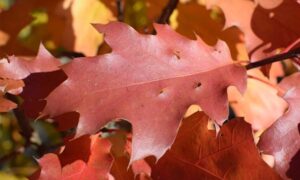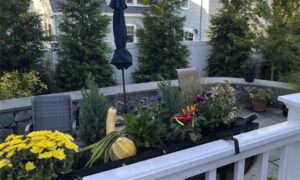No one among us can solve climate change. It is a bigger problem than that and needs governments and countries thinking and working globally. But we can help by focusing on building the most sustainable, meaningful landscapes we can. I think of it as holding the line for the many creatures who I love to see in and around my garden.
Sustainable landscapes use mostly native plants. They are maintained with sustainable gardening practices. And they collect and use all the water that falls on the property.
Why native plants?
These plants evolved over thousands of years alongside our native songbirds, bugs, pollinators, reptiles, and mammals. Therefore, they offer those creatures a chance of survival in an ever growing difficult, treacherous world.
Plant one Red or White Oak Tree and you will feed baby birds from hatching to fledging for hundreds of years.
Plant a stand of Viburnums and you will feed over wintering birds a high fat, high sugar diet when they need it most.
Plant a couple of Solidago and Monarda and you will enjoy the sight of native bees, butterflies and hummingbirds feasting on them all summer long.
Sustainable practices?
There is a new kind of beauty being enjoyed by those of us using sustainable practices. And doing so allows us to relax in our gardens more than ever.
Leave the leaves in the fall and spring and allow fireflies to make a comeback. Leaves are where good bugs overwinter, lay their eggs and live often for a year before emerging as a butterfly, a firefly or a native bee! Birds find food in these leaves all winter and spring as well. And the leaves serve as a mulch and then as a plant food to the shrubs and trees they are under.
Stop cleaning your garden! Some foliage absolutely needs to be removed and disposed of. Think Peony or Tomato foliage. But many stalks of our native plants offer a place to live over the winter and to lay eggs for hatching in the summer. Instead of cutting your perennials gardens down to the ground every fall, leave the stalks at about 12 inches. Then in the spring the new growth will grow up through them and hide them completely. That allows the next generation of bugs, aka, baby bird food, to thrive.
Leave snags for birds. If you can, don’t remove a tree all the way to the ground. It is amazing to see the life a snag or two can introduce to your property. Woodpeckers of all sizes visit to harvest the bugs. As they work they make holes large enough for Chickadees to use as houses to raise their young. And eventually over many years the snag will rot and become part of the healthy garden floor.
Save your water!
Old practices designed to gather and remove water from your property as quickly as possible are thankfully being rethought. In times of severe drought it is important to save water wherever possible and to eliminate plants that require lots of water. Gather water in rainbarrels and cisterns, install rain gardens, reduce the size of your water greedy lawns, and plant more trees and shrubs. Install gravel driveways and permeable patios. Practice water saving techniques when watering your landscape.
And finally…don’t be a sociopath.
If you are actively inviting butterflies and bees and other pollinators to your yard do not use poisons in your yard. Ever. If you are killing ticks you are killing every good bug too. If you are killing mosquitoes every bug is murdered too. There are sustainable ways to keep ticks and mosquitoes at bay but using poison is a big no no. Look to keep chickens to keep ticks down. Or spray with garlic to keep mosquitoes at bay.
Keep your songbird killers inside! Those would be cats! I love my cats, but they and their ilk are the leading cause of death (in the billions by the way) of our local songbirds. That is just unacceptable and so easy to solve. Kitties love to look out the window at the birds- they are safe from coyotes and foxes and the birds are safe from them!



